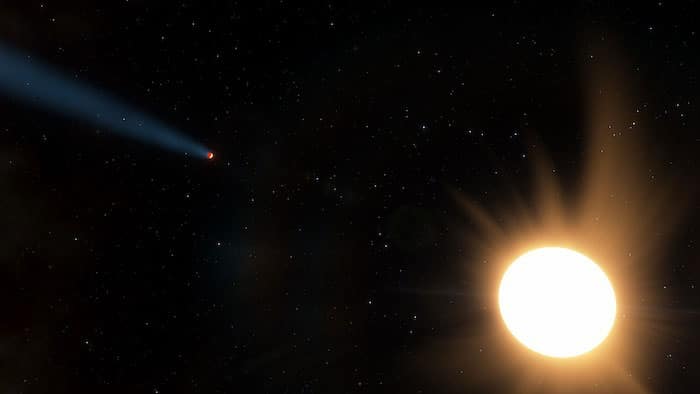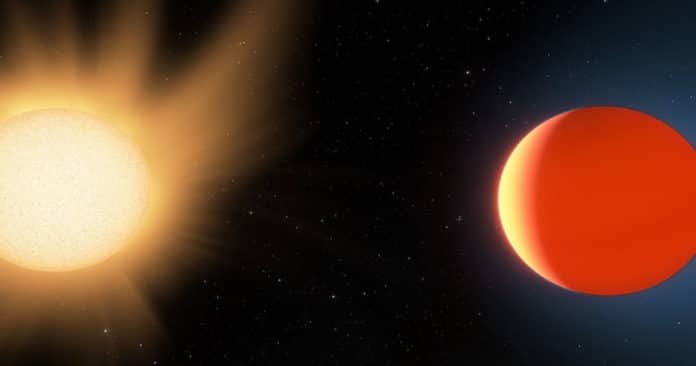Using data from NASA’s TESS and Spitzer space telescopes, a team of astronomers from the University of Kansas portrayed the atmosphere of a highly unusual kind of exoplanet ‘LTT 9779b’, also dubbed a “hot Neptune.”
For the first time, astronomers detailed the spectral atmospheric characterization of any planet discovered by TESS. They measured the light emerging from this planet that should not exist.
LTT 9779b is an extraordinary planet. It orbits so close to its star that its year lasts only 19 hours, and stellar radiation heats the planet to 1,727 degrees Celsius (3,141 degrees Fahrenheit). Its atmosphere could have evaporated entirely. Yet, Spitzer’s observations show us its atmosphere via the infrared light the planet emits.
Moreover, the planet doesn’t have a solid surface, and it’s much hotter even than Mercury in our solar system.

Discovered last year, the planet is becoming one of the first Neptune-sized planets found by NASA’s all-sky TESS planet-hunting mission.
The team measured how the planet was emitting much-infrared light as it rotates 360 degrees on its axis.
Ian Crossfield, assistant professor of physics & astronomy at KU and lead author of the paper, said, “Infrared light tells you the temperature of something and where the hotter and cooler parts of this planet are—on Earth, it’s not hottest at noon; it’s hottest a couple of hours into the afternoon. But on this planet, it’s hottest just about at noon. We see most of the infrared light coming from the part of the planet when its star is straight overhead and a lot less from other parts of the planet.”
Co-author Nicolas Cowan of the Institute for Research on Exoplanets (iREx) and McGill University in Montreal said, “The planet is much cooler than we expected, which suggests that it is reflecting away much of the incident starlight that hits it, presumably due to dayside clouds. The planet also doesn’t transport much heat to its nightside, but we think we understand that: The starlight that is absorbed is likely absorbed high in the atmosphere, from whence the energy is quickly radiated back to space.”
Crossfield said, “The results are just a first step into a new phase of exoplanetary exploration as the study of exoplanet atmospheres steadily moves toward smaller and smaller planets.”
“I wouldn’t say we understand everything about this planet now, but we’ve measured enough to know this is going to be a fruitful object for future study. It’s already being targeted for observations with the James Webb Space Telescope, which is NASA’s next big multibillion-dollar flagship space telescope that’s going up in a couple of years.”
“What our measurements so far show us are what we call the spectral absorption features—and its spectrum indicates carbon monoxide and or carbon dioxide in the atmosphere. We’re starting to get a handle on what molecules make up its atmosphere. Because we see this, and because of how this global temperature map looks, it also tells us something about how the winds are circulating energy and material around through the atmosphere of this mini gas planet.”
“Although LTT 9779b isn’t suitable for colonization by human beings or any other known life form, evaluating its atmosphere would hone techniques that someday could be used to find more welcoming planets for life.”
“If anyone is going to believe what astronomers say about finding signs of life or oxygen on other worlds, we’re going to have to show we can do it right on the easy stuff first. In that sense, these bigger, hotter planets like LTT 9779b act like training wheels and show that we know what we’re doing and can get everything right.”
“Much work is left to do to understand LTT 9779b and similar hot Neptunes better not yet discovered. We want to continue observing it with other telescopes so that we can answer more questions.”
Björn Benneke of iREx and the Université de Montréal said, “We detected carbon monoxide in its atmosphere and that the permanent dayside is very hot, while very little heat is transported to the night side. Both findings make LTT 9779b say a powerful signal to be observed, making the planet a very intriguing target for future detailed characterization with JWST. We’re now also planning much more detailed phase curve observations with NIRISS on JWST.”
The findings concerning the recently found planet LTT 9779b were published in Astrophysical Journal Letters.
